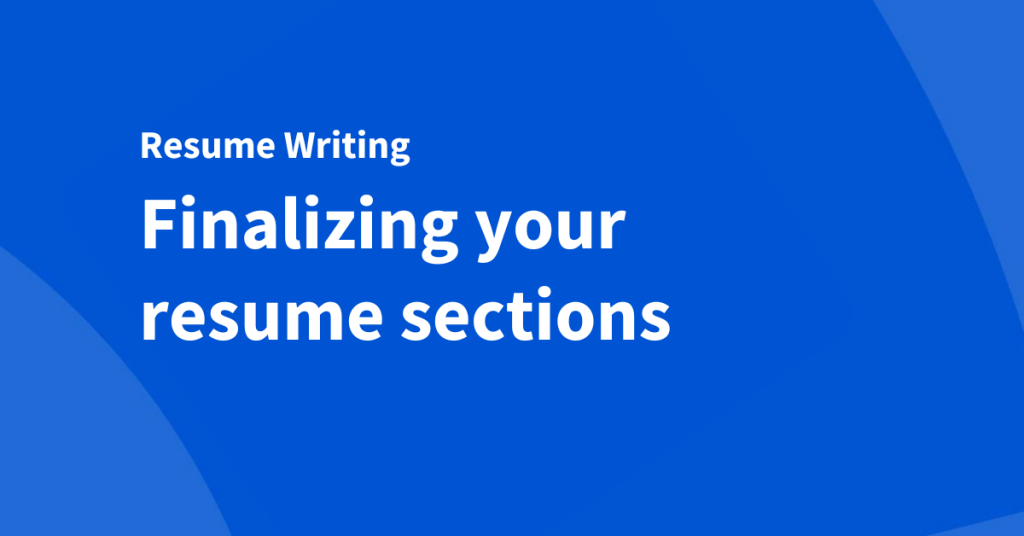How to actually write your resume, part two


Hi there!
This is it: the final resume stretch.
To recap our journey so far, you’ve contemplated your career goals, identified your key job skills, chosen your resume type, and started writing your resume. Today, we’re going to talk through more resume sections that you may want to include: education, certifications, hobbies, volunteer work, and skills.
Like last week, we’re covering a lot of ground, so let’s dig in.
Here’s part two of your resume breakdown, section-by-section.
Education
Your education section can be concise. All you need to include is your institution name and the degree you earned. If it’s relevant to your career path, you can also include your field of study. If a job requires a degree, these pieces of information are usually enough to show that you meet that requirement.
There’s generally no need to include your graduation year. Graduation year is one way unconscious bias (or ageism) can sneak into the application process, so it’s becoming more common for applicants to leave this information off.
An exception to this guideline is if you are a recent or soon-to-be graduate. In this case, including your graduation date or anticipated graduation date can help contextualize your experience. To demonstrate mastery of your subject matter, you can also include your GPA, as well as honors, achievements, relevant coursework, and extracurricular activities.
Certifications and certificates
Some roles require that job candidates have certain certifications—this tends to be common among advanced cybersecurity positions, for example—but outside of these instances, including your certifications or professional certificates on your resume can be one more way to demonstrate that you have the job skills necessary to succeed in a role. In this section, include the certification name, awarding institution, expiration date (if applicable), and skills associated with earning this certificate.
Career change tip: Certificates can be a great way to add resume keywords that you may not be able to include in your work experience section. For example, if you’re aiming to shift from an administrative support role into a decision-making role, you may take Wharton’s Business Analytics Specialization to show that you understand how to use data to drive positive business results. (Perhaps you’ll even include your capstone project in a portfolio!)
Hobbies and volunteer work
Sections for hobbies and volunteer work aren’t must-haves for every resume, but they can be beneficial if you use them strategically. Because these are less common, you have some freedom in the way you format them; a list of bullet points will typically suffice. The important thing, as always, is to tie the items in this section back to the role you want to get.
Skills
Some people like to add a designated skills section in order to incorporate the resume keywords that they suspect the applicant tracking systems are looking for—but throughout your journey in this series, you’ve already built your entire resume around your most desirable skills. At this point, your skills section will be more of a storytelling mechanism than a necessary strategic element, so you get to decide whether this section is worth the real estate on your page.
Typically formatted as a bulleted list of skills, you can place this section either toward the top of your resume (underneath your objective or summary statement) or at the bottom. At the top, this section will offer a preview of what recruiters and hiring managers can expect to see on your resume, and at the bottom, it will sum up everything you shared above. This repetition can help reinforce the skills you most want to be known for during this hiring process.
Now for some final quick tips:
- Double-check that your margins are set to 1-inch all around and make sure your font size and spacing is easy to read.
- Revisit your job skills list and confirm that you’ve included the most important skills for your desired role.
- Edit your resume line-by-line to check your spelling and grammar.
Once you feel satisfied, give your document one final re-read from top to bottom. Take a moment to reflect on the series of accomplishments and gains that make up your career journey so far, and to feel proud of everything you’ve done. Imagine what you’ll be able to do next.
That’s a wrap on our resume writing series. To keep exploring, check out our resume writing guide and LinkedIn profile tips, or consider enrolling in SUNY Online’s How to Write a Resume course, which takes about five hours to complete. As always, feel free to drop any other resume questions you have in the comments below.
We’ll be back next week with something new. See you then.


